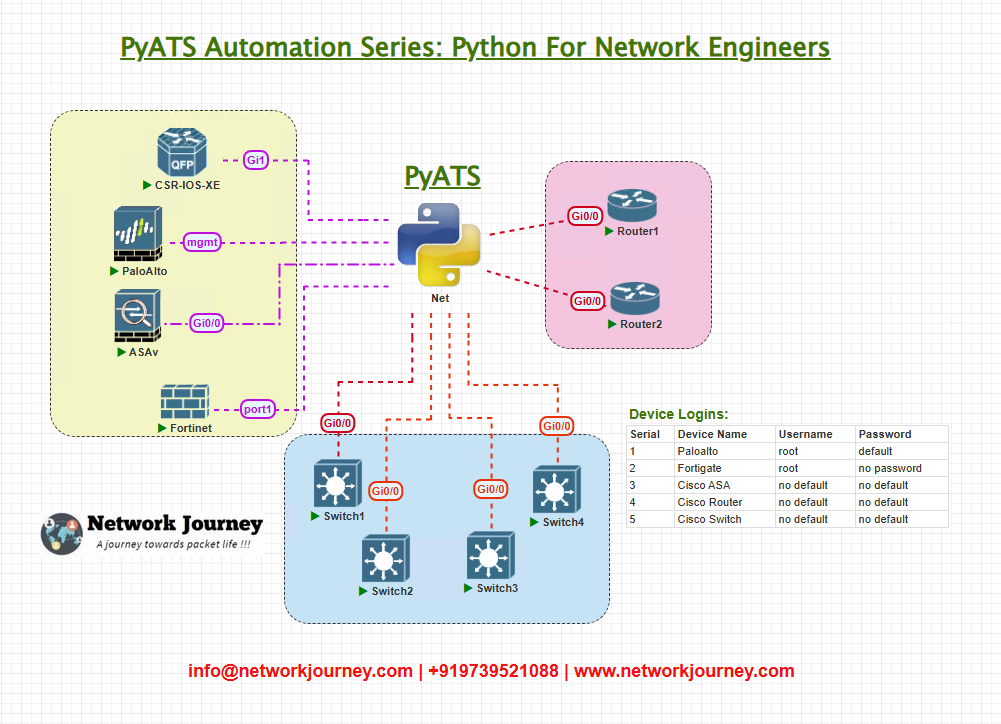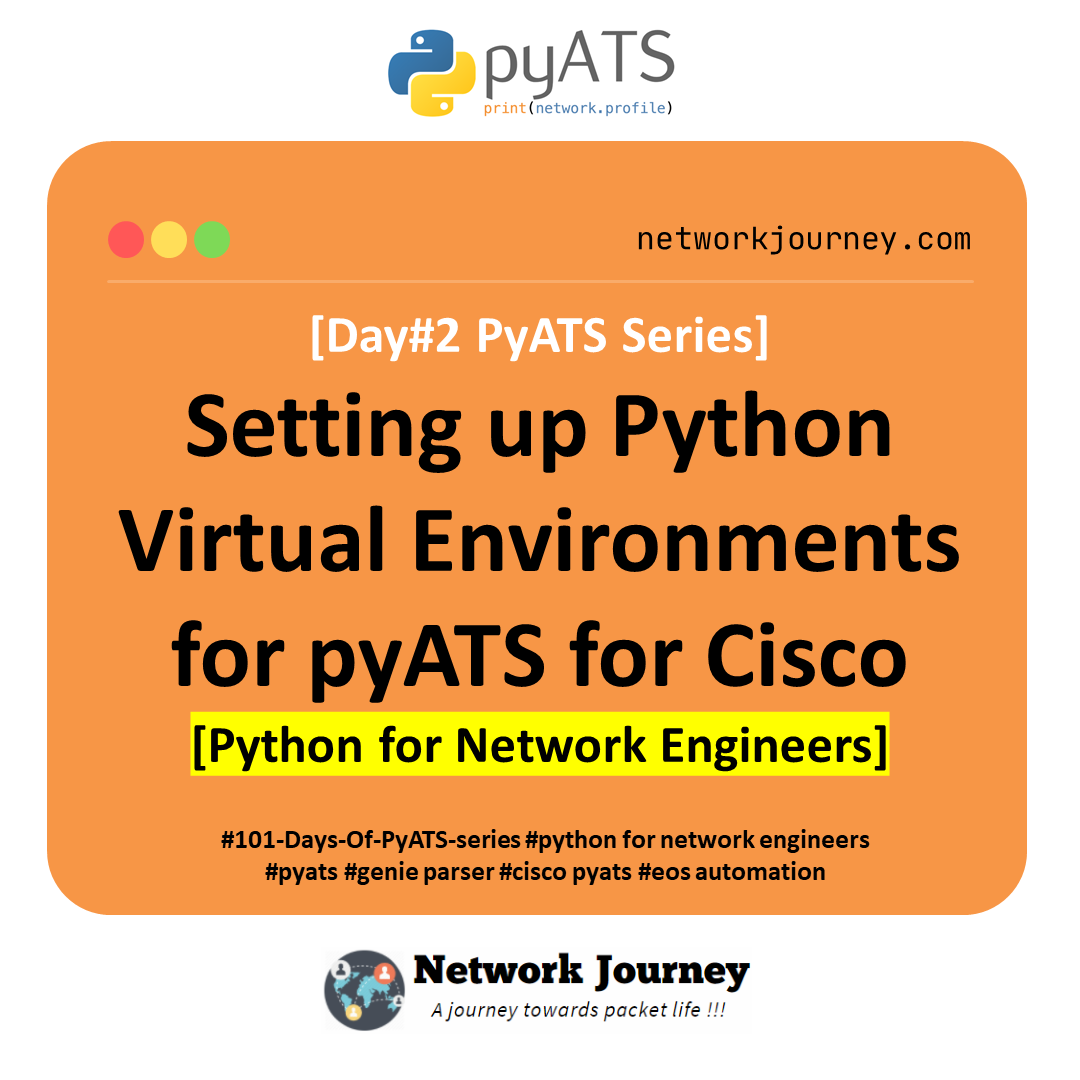[Day#2 PyATS Series] Setting up Python Virtual Environments for pyATS for Cisco [Python for Network Engineer]
Table of Contents
1. Introduction on the Key Points
In the evolving world of network automation, learning how to integrate Python for Network Engineer tasks has become essential. If you’re a Cisco network professional looking to automate testing, validation, or configuration, pyATS (Python Automated Test System) is your best friend.
In this second article of our multi-day pyATS series, we will walk through setting up a clean and isolated Python virtual environment. This setup allows you to manage dependencies, keep your automation scripts clean, and prepare for real-world projects involving Cisco routers, switches, firewalls, and SD-WAN platforms.
By the end of this article, you will:
- Understand why virtual environments are crucial
- Set up a
venvfor pyATS using best practices - Install pyATS core components and verify their versions
- Begin your journey toward automating network testing the right way
2. Topology Overview

Though today’s task is environment setup, here is the logical flow we’ll be using in later labs:
All devices will be accessed via SSH from your local machine using the testbed YAML file (which we’ll preview later).
3. Topology & Communications
We’ll focus on:
- pyATS virtual environment setup
- Installing required modules (pyats, unicon, genie)
- Validating connectivity to testbed (router/switch)
This is the foundation for running real-world tests like interface status checks, configuration drift detection, or ping reachability.
4. Workflow Script
Here’s a simplified script that validates your pyATS environment is set up correctly:
# Step 1: Create Python venv python3 -m venv pyats_lab_env # Step 2: Activate it source pyats_lab_env/bin/activate # For Linux/macOS # pyats_lab_env\Scripts\activate # For Windows # Step 3: Install pyATS pip install pyats[full] # Step 4: Confirm installation pyats version check # Optional: Upgrade pip python -m pip install --upgrade pip
5. Explanation by Line
python3 -m venv pyats_lab_env: Creates a self-contained environment calledpyats_lab_envsource pyats_lab_env/bin/activate: Activates the environment so that all installations remain isolatedpip install pyats[full]: Installs the entire pyATS suite, including unicon and genie librariespyats version check: Validates that pyATS and its components are correctly installed
6. testbed.yml Example
testbed:
name: cisco_testbed
credentials:
default:
username: admin
password: cisco123
devices:
R1:
os: iosxe
type: router
connections:
cli:
protocol: ssh
ip: 192.168.1.1
Save this as testbed.yml in your project folder.
7. Post-validation CLI Screenshots (Real expected output)
After installation, run:
pyats version check
Expected output:
| Package | Version | |--------------|----------| | pyats | 23.5 | | unicon | 23.5 | | genie | 23.5 |
FAQs
Q1: Why should I use a Python virtual environment when working with pyATS?
Answer:
A Python virtual environment isolates your pyATS installation and its dependencies from the system-wide Python setup. This is crucial because:
- It prevents conflicts between different Python packages or versions.
- Allows you to create multiple environments for different projects (e.g., pyATS for Cisco, Ansible automation).
- Keeps your base operating system clean and stable.
- Makes it easier to upgrade or remove pyATS without affecting other Python applications.
Q2: What Python version should I use for setting up pyATS?
Answer:
Cisco officially supports Python 3.6 to 3.10 for pyATS. It is recommended to use:
- Python 3.8 or 3.9 for maximum compatibility.
- Avoid using Python 3.11+ as some libraries might not yet fully support it.
- You can check your Python version with:
python3 --version
Q3: How do I create a Python virtual environment for pyATS?
Answer:
Follow these steps:
- Install Python and
venvif not already installed:sudo apt update sudo apt install python3 python3-venv - Create a virtual environment:
python3 -m venv pyats_venv - Activate the environment:
source pyats_venv/bin/activate - Install pyATS:
pip install pyats[full]
Q4: How do I know my virtual environment is active?
Answer:
When a virtual environment is active:
- Your terminal prompt changes to show the environment name (e.g.,
(pyats_venv) user@server). which pythonorwhich pippoints to the virtual environment’s directory instead of the system path.- Any packages installed via
pipgo into the isolated environment folder.
Q5: Can I deactivate or remove a virtual environment without affecting pyATS?
Answer:
Yes. To deactivate:
deactivate
To remove the environment completely:
rm -rf pyats_venv
This will not harm your system Python or other projects since everything is contained within the pyats_venv directory.
Q6: How can I manage multiple virtual environments for different projects?
Answer:
You can create multiple environments, each with different package versions:
python3 -m venv pyats_project1 python3 -m venv pyats_project2
Activate the one you need before running your scripts. Tools like virtualenvwrapper or pyenv can help manage multiple environments easily.
Q7: What is the difference between venv and virtualenv for pyATS?
Answer:
venv: Built-in with Python 3.x, simpler to use, no extra installation needed.virtualenv: A third-party tool that works for both Python 2 and 3 and offers additional features like faster environment creation.
For most pyATS use cases,venvis sufficient and recommended.
Q8: Do I need to activate the virtual environment every time I use pyATS?
Answer:
Yes. Each time you open a new terminal session and want to work with pyATS, you must activate the environment:
source pyats_venv/bin/activate
This ensures you’re using the correct Python interpreter and installed packages.
YouTube Link
Watch the Complete Python for Network Engineer: Setting up Python Virtual Environments for pyATS (Ping Tests) using pyATS (Vendor-Agnostic) – Cisco, Arista, Palo Alto, Fortigate Lab Demo & Explanation on our channel:
Join Our Training
If you’re enjoying this hands-on series and want to fast-track your journey into network automation, I invite you to join our 3-month instructor-led training:
Course: Python, Ansible, API & Cisco DevNet for Network Engineers
Check Full Curriculum Here
Led personally by Trainer Sagar Dhawan, this course is designed to:
- Turn you into a confident Python for Network Engineer
- Teach real-world use of pyATS, Ansible, REST APIs
- Build real labs across Cisco, Arista, Palo Alto, Fortigate
Enroll Now & Future‑Proof Your Career
Email: info@networkjourney.com
WhatsApp / Call: +91 97395 21088
Seats fill fast — start your automation journey today.

![[Day #95 PyATS Series] Automate Cable Matrix Validation (LLDP/CDP Topology) using pyATS for Cisco [Python for Network Engineer]](https://networkjourney.com/wp-content/uploads/2025/09/Day-95-PyATS-Series-Automate-Cable-Matrix-Validation-LLDP_CDP-Topology-using-pyATS-for-Cisco-Python-for-Network-Engineer-470x274.png)
![[Day #34 PyATS Series] DHCP Snooping & Binding Table Verification Using pyATS for Cisco [Python for Network Engineer]](https://networkjourney.com/wp-content/uploads/2025/08/Day-34-PyATS-Series-DHCP-Snooping-Binding-Table-Verification-Using-pyATS-for-Cisco-Python-for-Network-Engineer.png)
![[Day #68 PyATS Series] Check end-to-end multicast routing across domains using pyATS for Cisco](https://networkjourney.com/wp-content/uploads/2025/09/Day-68-PyATS-Series-Check-end-to-end-multicast-routing-across-domains-using-pyATS-for-Cisco-470x274.png)